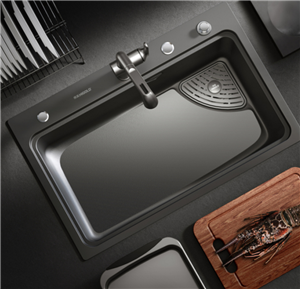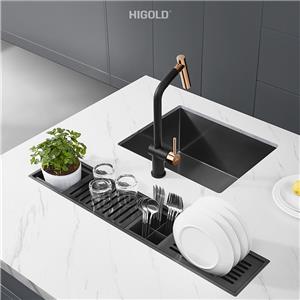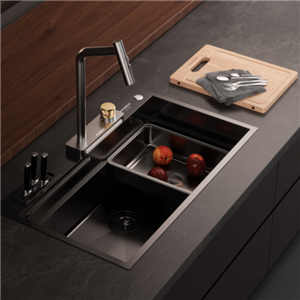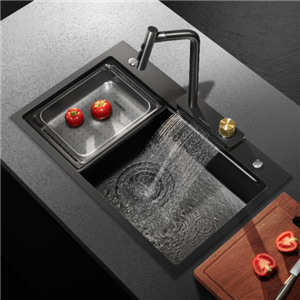Why has my composite kitchen sink turned white?
In modern kitchens, composite sinks are widely favored for their high performance, durability and stylish appearance. This type of sink is usually made of a combination of various materials, such as natural minerals, quartz and resin, so it has both the hardness of stone and the lightness and plasticity of plastic. However, many consumers find that the surface of the composite kitchen sink has turned white, discolored or darkened after using it for a period of time, which confuses many people.
So, why does the composite sink turn white? Can this change be avoided? Can it be repaired? This article will analyze in detail from many aspects to help consumers understand the reasons for the whitening of composite sinks and provide effective prevention and solutions.
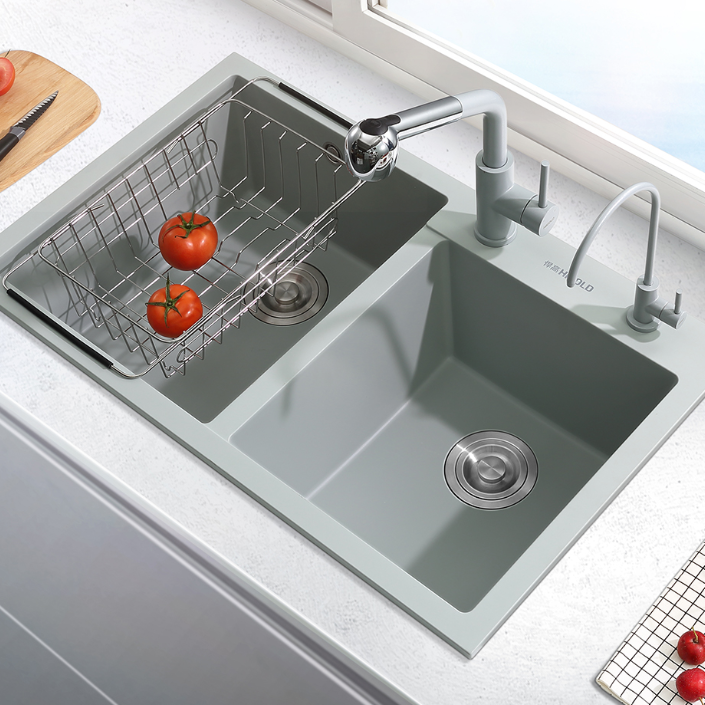
Why has my composite kitchen sink turned white?
The whitening phenomenon of composite sinks is mainly manifested in the appearance of white spots, white films or white deposits on the surface of the sink. This phenomenon is common after long-term use, especially in some cases of improper cleaning and maintenance or poor water quality. The reasons for the whitening of composite sinks can be discussed from the following aspects.
1. Water quality issues
Although the material of the composite sink is strong, it is sensitive to changes in water quality. In particular, when hard water (water containing a large amount of calcium and magnesium ions) contacts the surface of the composite sink for a long time, scale will form on the surface of the sink. These scales are usually white, so when there is a lot of scale on the surface of the sink, white spots or white film are likely to appear.
The impact of hard water on composite sinks: The calcium and magnesium ions in hard water react with the resin or minerals on the surface of the sink to form white deposits. If these deposits are not cleaned in time, they will gradually accumulate and cause the surface of the sink to turn white.
2. Long-term contact with chemicals
The surface of the composite sink is easily corroded by chemicals, especially some detergents containing acidic or alkaline ingredients. When in contact with these detergents or chemicals for a long time, the resin layer on the surface of the composite sink may react chemically, causing the surface to discolor and white marks or spots to appear. In particular, some strong acid or strong alkaline detergents that are not suitable for cleaning composite sinks will accelerate the aging of the resin layer and affect the appearance and quality of the sink.
Common chemicals include:
● Chlorine-containing bleach
● Strong acidic or alkaline detergents
● Bleaching powder or other decontamination products
3. Failure to clean stains in time
The surface of composite sinks is usually smooth, and stains and water stains are easy to adhere to. If they are not wiped dry or cleaned in time after use, water stains, oil stains, food residues, etc. may remain on the surface of the sink, forming a phenomenon similar to a white film. Over time, these stains may become more stubborn and eventually form white marks.
The impact of long-term accumulation of stains: If the surface of the sink is not cleaned for a long time, scale and food residues may react with minerals in the water, resulting in the accumulation of white deposits and water stains. These stains are difficult to remove and give the sink permanent white marks.
4. Improper maintenance in daily use
Composite sinks require regular maintenance and cleaning to maintain their appearance and performance. If the accumulated water, oil or stains in the sink are not handled in time during use, it may cause surface wear, aging and even discoloration, and eventually white changes. In addition, using too hard cleaning tools (such as steel wool or too rough brushes) may also cause scratches on the surface of the sink, making it easier for stains and scale to adhere to these scratches, thereby exacerbating the whitening of the sink.
5. Aging of the sink material
Composite sinks are usually made of a mixture of resin and minerals, and these materials will gradually age during long-term use. The aging of the resin layer will not only affect the glossiness of the sink, but may also cause changes in the color of the sink surface. Especially when the sink has been used for a long time, the resin reacts with the minerals and dirt in the water, and it is easy to turn white or fade.
The impact of resin aging: The aging of the resin layer will cause the surface of the sink to gradually become rough, affecting the gloss of the sink and making it lose its original bright appearance. After the resin ages, it is also easy to absorb more stains, causing the surface of the sink to turn white.
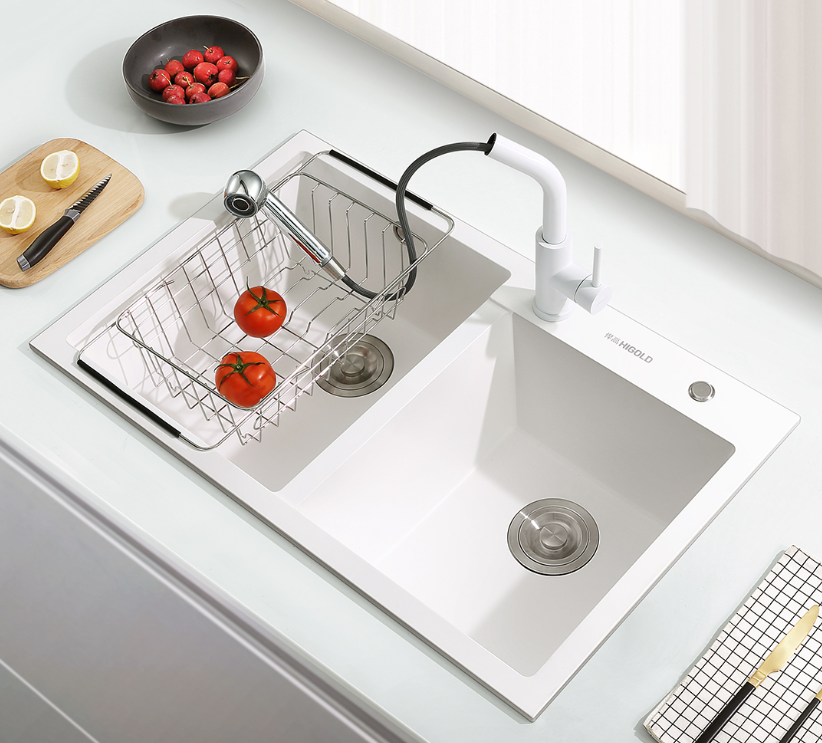
How to prevent composite sinks from turning white?
Although there are many reasons for the whitening of composite sinks, some simple preventive measures can effectively reduce the occurrence of this phenomenon. Here are some practical prevention tips to help consumers keep composite sinks clean and bright in daily use.
1. Clean the sink regularly
Regular cleaning of composite sinks is the key to preventing sinks from turning white. After daily use, rinse the sink with clean water in time and wipe it dry with a soft cloth or sponge to prevent water and oil stains from accumulating. Perform a comprehensive cleaning once a week, wipe the surface of the sink with a neutral detergent to remove stains and scale, and maintain the smooth surface of the sink.
Cleaning tips:
● Avoid using strong acid or strong alkaline detergents.
● Use a mild neutral detergent.
Clean regularly with a soft cloth or sponge, and do not use hard tools such as steel wool.
2. Prevent hard water scaling
If the water quality at home is hard, it is recommended to use a water softener or filter to reduce the content of calcium and magnesium ions in the water to prevent scale from depositing on the surface of the sink. Clean the scale on the sink regularly to prevent long-term accumulation of scale and cause the sink to turn white.
Solution:
● Install a water softener to improve water quality.
● Use a professional descaling cleaner to regularly remove scale on the surface of the sink.
● After each use of the sink, try to dry the sink to avoid water stains for a long time.
3. Avoid using strong chemical cleaners
When cleaning composite sinks, avoid using cleaners containing chlorine, acidic or strong alkaline ingredients. Choose a cleaner designed for composite sinks to gently and effectively remove oil stains and dirt without damaging the sink surface.
Chemicals to avoid include:
● Bleach
● Strong acidic or alkaline cleaners
● Chlorine-containing bleaching powder
4. Keep the surface of the sink smooth
To prevent the surface of the sink from being worn, a special maintenance agent can be used to protect the resin layer on the surface of the sink. Perform regular maintenance to prevent the surface of the sink from becoming rough due to friction, which increases the chance of stains accumulating.
Maintenance tips:
● Apply a special sink maintenance agent regularly to keep the surface of the sink smooth.
● Avoid scratching the surface of the sink with hard objects.
● Use a soft cloth or sponge to clean the sink.
5. Improve the precautions in use
In daily use, try to avoid putting overheated pots and tableware directly into the sink to avoid discoloration or damage to the sink surface caused by drastic temperature differences. You should also avoid storing food residues or oil in the sink for a long time, and keep the sink clean and dry.
Daily use suggestions:
● Avoid putting hot pots directly into the sink.
● Do not put overly greasy food residues in the sink for a long time.
● Clean the food residue in the sink regularly to prevent contamination of the sink.
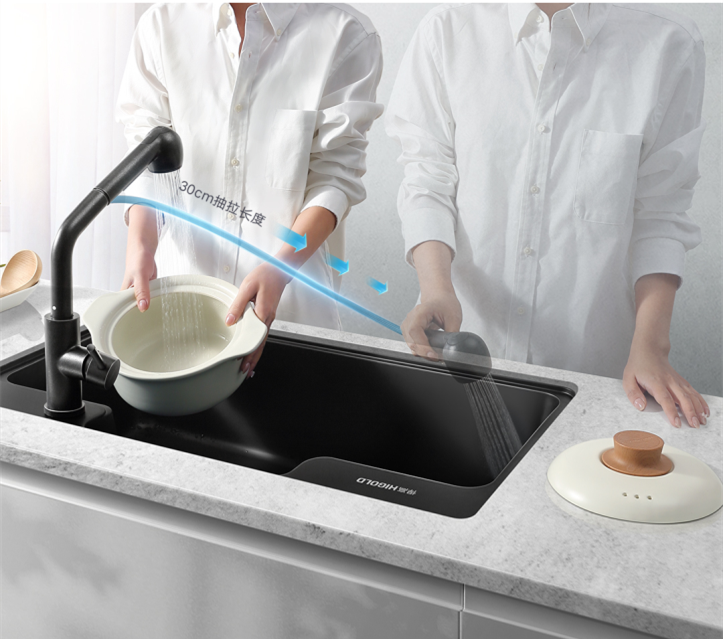
How to repair white spots on composite sinks?
If the composite sink has white spots or whitening, consumers can try the following methods to repair it.
1. Use professional cleaners
There are cleaners designed for composite sinks on the market that can help remove scale and stains accumulated on the surface of the sink. These cleaners usually contain mild chemical ingredients that can effectively clean the sink without damaging its surface.
2. Use soft cloth and warm water
For lighter white spots, wiping with a soft cloth, warm water and neutral detergent can effectively remove stains. Avoid using rough brushes or steel wool, which may scratch the sink surface and make the problem worse.
3. Have it repaired by a professional
If the composite sink surface is severely damaged and cannot be repaired by self-cleaning, it is recommended to have it repaired or replaced by a professional. Some brands of composite sinks offer a restoration service that can help repair surface scratches or discoloration and restore the sink's shine and beauty.
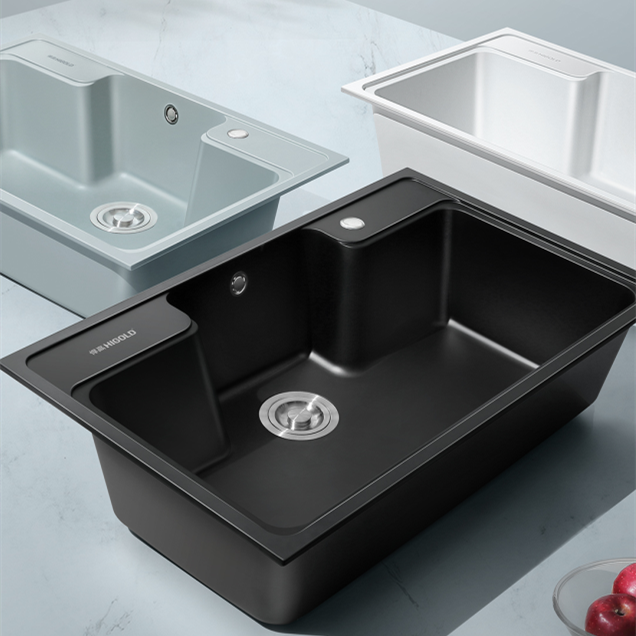
Buy Customized Kitchen Sinks & Faucets
Looking for customized kitchen hardware? Higold Group Co., Ltd. offers premium stainless steel Inox sinks and faucets, designed to meet your specific requirements. Our manufacturing processes are backed by advanced technology, ensuring superior quality at competitive prices. We specialize in ODM and OEM services, and our products are exported globally to over 86 countries. Whether you're buying in bulk or placing a small order, Higold provides tailored solutions that fit your needs and budget.

